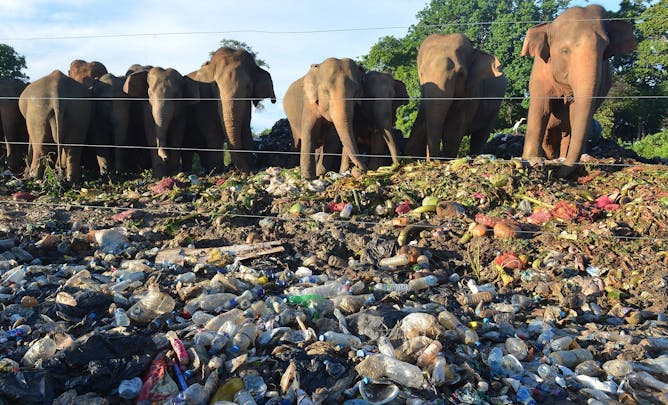|
Top headlines
Lead story
If you were an elephant in the 1700s, you could have roamed across nearly half of Asia and always found suitable habitat where you could live. Today, things are very different.
In a newly published study, University of California, San Diego ecologist Shermin de Silva and her colleagues analyzed land-use changes stretching back centuries to understand just how drastically human activities have shrunk and fractured habitat for endangered Asian elephants. The bottom line is that the elephants’ survival depends on humans finding ways to coexist with them, de Silva writes.
[Sign up here to our topic-specific weekly emails.]
|

Habitat loss has driven Asian elephants, like these foraging at a garbage dump in Sri Lanka, into human areas.
Lakruwan Wanniarachchi/AFP via Getty Images
Shermin de Silva, University of California, San Diego
A new study looks back into history to assess human impacts on the range of Asian elephants and finds sharp decline starting several centuries ago.
|
Economy + Business
|
-
Kelsey Pukelis, Harvard Kennedy School
A team of economists looked at what happened after Supplemental Nutrition Assistance Program work requirements were reinstated in Virginia in 2013.
|
|
Education
|
-
Jeremiah Favara, Gonzaga University
The US military’s switch to an all-volunteer force in 1973 led to a series of magazine ads that sought to portray military service as a way for women and people of color to move up in society.
|
|
Politics + Society
|
-
Davis W. Houck, Florida State University
While Bryant Donham was never charged for her involvement in Till’s death, the Justice Department continued to investigate the case and consider the potential for an arrest as recently as 2021.
-
Christopher Tounsel, University of Washington
Sudan’s location and natural resources have attracted international partners keen to benefit either geopolitically or economically.
|
|
Health + Medicine
|
-
Prakash Nagarkatti, University of South Carolina; Mitzi Nagarkatti, University of South Carolina
Researchers are working to determine how and which cannabis products can help those suffering from chronic pain or serious illness. But science is having a hard time keeping up with the booming market.
|
|
Arts + Culture
|
-
A. Joseph Dial, Purdue University
The film conveys an uncomfortable truth: Jordan was merely a vessel for Nike’s meteoric rise.
|
|
Podcast 🎙️
|
-
Daniel Merino, The Conversation; Mend Mariwany
Older imported cars pose risks to motorists and spew pollution. Some countries, including Ghana, are taking steps to limit the harms of this piece of the vehicle life cycle.
|
|
|
|